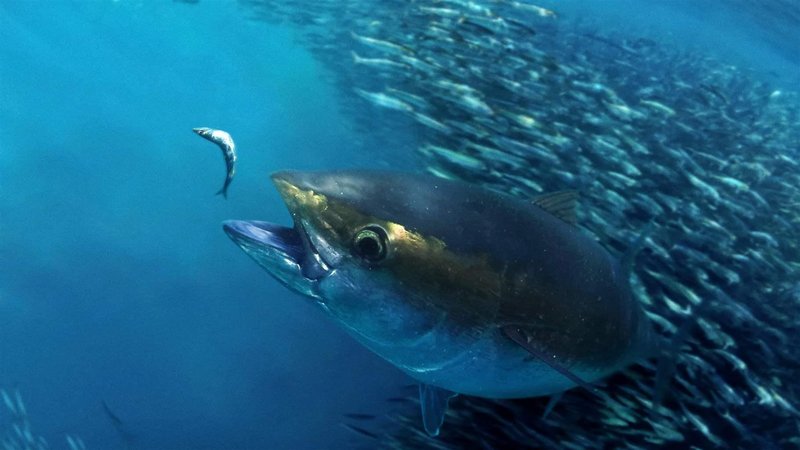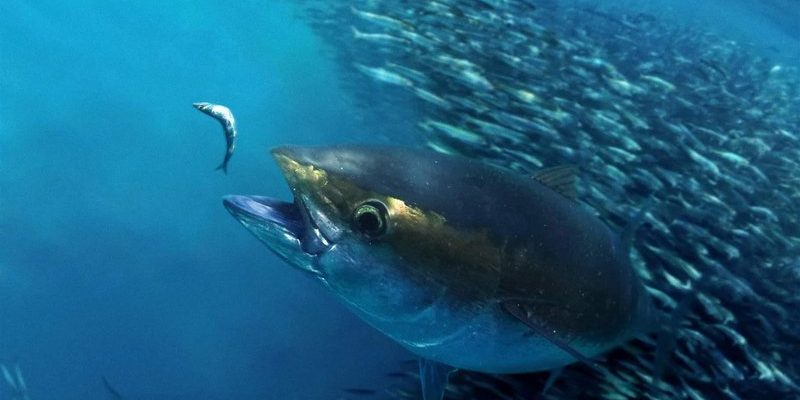
Bigeye tuna, known scientifically as Thunnus obesus, is a remarkable fish that swims through the world’s oceans, capturing the interest of both fish enthusiasts and commercial fishermen. Imagine a sleek, powerful creature darting through the water with grace and speed. This species is not just striking in appearance but also plays a significant role in marine ecosystems.
Typically found in tropical and subtropical waters, the Bigeye tuna is most famous for its large eyes, which help it see in the dim light of the deep ocean. This adaptation is crucial, allowing the fish to hunt effectively at varying depths. With its streamlined body and impressive swimming speed, the Bigeye can reach lengths of over six feet and weigh up to 400 pounds. It’s no wonder this fish is a favorite among sport fishermen!
As we dive deeper into the world of Bigeye tuna, you’ll discover essential facts about its habitat, behavior, and challenges it faces in today’s oceans. So, grab your snorkel gear (metaphorically speaking) and let’s explore this fascinating fish.
Physical Characteristics
The Bigeye tuna is an impressive fish, featuring a unique combination of physical attributes that make it stand out. Its body is elongated and streamlined, optimized for fast swimming. The coloration is another intriguing aspect, with a dark blue to black back, golden-yellow fins, and a silvery belly—a classic trait of many tuna species. This coloration not only provides camouflage from predators above but also helps with thermoregulation in various water temperatures.
One of its most distinguishing features is its large, prominent eyes, which are adapted for low-light conditions. This adaptation is particularly vital as the tuna hunts for prey in deeper waters where sunlight rarely penetrates. The eyes help it identify smaller fish such as sardines and mackerel, which make up a significant portion of its diet. The size of these eyes is so notable that it’s part of what gives this species its name: Bigeye tuna.
Additionally, their fins are not just for show. The dorsal fin is quite high and is equipped with spines, which can create a formidable defense mechanism against predators. Overall, the physical characteristics of the Bigeye tuna make it a truly remarkable creature, both beautiful and powerful, designed to thrive in the dynamic ocean environment.
Habitat and Distribution
Bigeye tuna are primarily found in tropical and subtropical waters, making the vast oceans their home. From the Atlantic to the Pacific, these fish enjoy the warmer waters where food is abundant. Their presence is often noted in both coastal and offshore regions, suggesting they are versatile swimmers. You might find them lurking around underwater structures like seamounts or continental shelves, where schools of smaller fish congregate.
Scientists have documented Bigeye tuna swimming at various depths, from the surface down to depths of 1,000 feet. This ability to dive deep and navigate through different depths enables them to catch their prey effectively. Interestingly, Bigeye tuna tend to be more active at night, utilizing their keen eyesight to hunt under the cover of darkness. This nocturnal behavior allows them to take advantage of the many smaller fish that also venture out to feed during the night.
Their wide distribution means that they are often targeted in commercial fishing due to their popularity and demand in sushi and sashimi dishes. However, this also raises concerns about their population levels and the sustainability of fishing practices. Understanding their habitat is crucial for promoting responsible fishing methods and conservation efforts.
Diet and Feeding Behavior
Bigeye tuna are not picky eaters; their diet consists primarily of smaller fish. Sardines, mackerel, and various squid species make up the majority of their meals. Think of them as the skilled hunters of the ocean, using their speed and agility to chase down their prey. With that large eye, they can spot food from a distance, allowing them to strike with precision.
The feeding behavior of Bigeye tuna is fascinating. They often hunt in groups, coordinating their efforts to corner schools of fish. Imagine a well-orchestrated team of athletes working together to score a goal—this is how Bigeye tuna operate when hunting. Sometimes, they even leap out of the water to catch prey in a spectacular show of skill, a sight that can leave onlookers in awe.
Further, Bigeye tuna are known for their unique feeding strategies. They can dive deep to chase down prey, making them incredibly versatile hunters. This adaptability is one of the reasons why they thrive in various ocean conditions. However, their reliance on certain fish species for food raises concerns about the impact of overfishing on their populations and, consequently, their own survival.
Reproduction and Lifespan
When it comes to reproduction, Bigeye tuna are fascinating creatures. They reach sexual maturity between three to five years of age, depending on environmental conditions and food availability. During spawning season, they partake in an impressive ritual, where they release eggs and sperm into the open water. This method, known as broadcast spawning, allows for the fertilization of eggs in the ocean’s currents.
Bigeye tuna have a high reproductive potential, with females laying thousands of eggs at a time. This abundance of eggs is essential for sustaining their populations, especially considering the number of natural predators and commercial fishing activities that pose threats to their survival. After a few days, the larvae hatch, and the young fish start their journey toward adulthood, navigating through a world full of challenges.
As for their lifespan, Bigeye tuna can live up to 12 years in the wild, although factors like overfishing and environmental changes can significantly impact their longevity. Their life cycle highlights the delicate balance of marine ecosystems and the importance of fostering a healthy environment where these remarkable fish can flourish.
Conservation Status
The Bigeye tuna, while a marvel of the ocean, faces numerous challenges that threaten its existence. Overfishing is the most pressing issue, as these fish are highly sought after in markets worldwide. Due to their popularity, particularly in sushi cuisine, they have become targets for commercial fishing fleets, leading to significant population declines.
Organizations and governments are increasingly aware of this issue, resulting in a push for sustainable fishing practices. Regulations are being implemented to limit catch sizes and ensure that juvenile fish are returned to the ocean. However, enforcement can be challenging, especially in international waters where monitoring is less stringent.
Another concern is climate change, which affects their habitat and food availability. Warmer ocean temperatures can lead to shifts in fish populations, making it harder for Bigeye tuna to find their preferred prey. Additionally, changing ocean currents can disrupt their migration patterns. Conservation efforts are essential, not only for the Bigeye tuna but for the overall health of our oceans. The challenge lies in balancing human needs with protecting marine wildlife.
Interesting Facts About Bigeye Tuna
| Average Length: | Up to 6.5 feet |
| Maximum Weight: | 400 pounds |
| Habitat: | Tropical and subtropical oceans |
| Diet: | Small fish and squid |
| Life Span: | Up to 12 years |
| Swimming Speed: | Up to 75 mph |
Bigeye Tuna in Culinary Traditions
Bigeye tuna is highly prized in various culinary traditions, especially in sushi and sashimi. The rich, flavorful meat is a favorite among seafood lovers, often served raw or lightly seared. This popularity has made it a staple in many sushi restaurants around the world, creating high demand in both local and international markets.
The taste of Bigeye tuna is often described as rich and buttery, with a smooth texture that melts in your mouth. When prepared correctly, it can be an unforgettable dining experience. Chefs often recommend serving it with soy sauce, wasabi, and pickled ginger to enhance its natural flavors. Additionally, it’s not uncommon for it to be grilled or used in gourmet seafood dishes.
However, the rising demand for Bigeye tuna also raises ethical concerns regarding overfishing and sustainability practices. As seafood lovers, it’s essential to be aware of the sources of our fish. Advocating for responsibly sourced Bigeye tuna can help protect this magnificent fish and ensure that it remains a part of our culinary traditions for generations to come.
Bigeye Tuna: A Symbol of Marine Health
The health of Bigeye tuna populations is often seen as a barometer of the overall health of our oceans. When we notice declines in their numbers, it sends a warning signal about the state of marine ecosystems. These fish are not only important as predators but also play a vital role in maintaining the balance of marine life.
Efforts to conserve Bigeye tuna can lead to broader initiatives that benefit various species. By protecting their habitats and ensuring sustainable fishing practices, we can help preserve the delicate balance of the ocean. This stewardship fosters a healthier environment for all marine life, which ultimately impacts our planet’s health.
As individuals, we can contribute by making informed choices about the seafood we consume and advocating for policies that promote ocean conservation. By prioritizing the health of species like the Bigeye tuna, we contribute to a sustainable future where our oceans thrive.
FAQ
How can I identify a Bigeye tuna?
You can identify a Bigeye tuna by its distinctive large eyes, streamlined body, and unique coloration of dark blue to black on the back and silver on the belly. They usually have a high dorsal fin and a pointed snout, which aids in their swift swimming through the ocean.
Are Bigeye tuna endangered?
Bigeye tuna are not classified as endangered, but they are considered overfished. Conservation efforts are in place to manage their populations, but their numbers are still vulnerable due to high demand in fisheries and changing ocean conditions.
What is the difference between Bigeye tuna and Yellowfin tuna?
While both species belong to the same family, they have some notable differences. Bigeye tuna have larger eyes and a bulkier body compared to Yellowfin tuna, which are generally leaner and faster. Additionally, the coloration differs slightly, with Yellowfin having distinct yellow stripes along its fins.
Can Bigeye tuna be farmed?
Yes, Bigeye tuna can be farmed, although it is more challenging than other fish species. Techniques for aquaculture are being developed to help reduce pressure on wild populations and meet the demand for this popular fish sustainably.
What is a typical lifespan of Bigeye tuna?
Bigeye tuna can live up to 12 years in the wild, although their lifespan may vary depending on environmental factors and fishing pressures. Understanding their lifespan helps in developing better conservation strategies.
Are Bigeye tuna migratory?
Yes, Bigeye tuna are migratory fish. They follow food sources and can travel long distances across oceans. Their migration patterns can be affected by changes in water temperature and food availability, making them an important species to study in the context of climate change.
What do Bigeye tuna eat?
The diet of Bigeye tuna primarily consists of small fish like sardines and mackerel, as well as squid. They are active predators, using their speed and vision to hunt effectively in the ocean.
How fast can Bigeye tuna swim?
Bigeye tuna are known for their speed, capable of swimming up to 75 miles per hour. This incredible speed aids them in hunting and escaping from predators in their marine environment.
What is the significance of Bigeye tuna in ecosystems?
Bigeye tuna play a crucial role in their ecosystems as apex predators. They help maintain the balance of marine life by controlling the populations of smaller fish, which ultimately supports the health of ocean ecosystems.
How does climate change affect Bigeye tuna?
Climate change affects Bigeye tuna by altering their habitat and prey availability. Warmer water temperatures can shift the locations of fish species they rely on for food, impacting their hunting success and overall survival.

